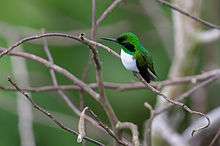Black-eared fairy
| Black-eared fairy | |
|---|---|
 | |
| Scientific classification | |
| Kingdom: | Animalia |
| Phylum: | Chordata |
| Class: | Aves |
| Order: | Apodiformes |
| Family: | Trochilidae |
| Genus: | Heliothryx |
| Species: | H. auritus |
| Binomial name | |
| Heliothryx auritus (Gmelin, 1788) | |
The black-eared fairy (Heliothryx auritus) is a species of hummingbird in the Trochilidae family. It is found in tropical forests in South America.
Subspecies
Three sub-species are recognised:[2]
- Heliothryx auritus auriculatus (Nordmann, 1835)
- Heliothryx auritus auritus (Gmelin, 1788)
- Heliothryx auritus phainolaemus Gould, 1855
Description
The black-eared fairy is a medium-sized tropical hummingbird. It has bright green upperparts, white underparts and a black mask. The relatively short, straight bill is black. The graduated tail is blue-black in the center, with white outer tail feathers (i.e. typically appear blue-black from above, white from below). Depending on subspecies, the male has a green malar or throat. The female is similar, but with a longer tail and no green malar/throat.
Distribution and habitat
This bird is found in Bolivia, Brazil, Colombia, Ecuador, French Guiana, Guyana, Peru, Suriname, and Venezuela. Its natural habitat is subtropical or tropical moist lowland forests.
Behaviour
Breeds all year around, nest is a cup made of down attached to a branch about 3-30 meter above ground. Clutch size is 2 eggs incubated by female for about 15 days. Young fledge after 23–26 days. Itbreeds for the first time when in its second year.
This hummingbird hawks small insects in the air, as well as gleaning them from foliage. When feeding on nectar, it sometimes pierces a small hole at the base of large flowers, giving access to nectar that otherwise would only be accessible to hummingbirds with longer bills.
Status
The black-eared fairy has a very large range. The population may be in decline because of degradation of its rainforest habitat and it is described as being uncommon. Nevertheless, the IUCN has listed it as being of "Least Concern" as the rate of decline in population is not considered to be fast enough to justify placing it in a more threatened category.[1]
References
- 1 2 BirdLife International (2012). "Heliothryx auritus". IUCN Red List of Threatened Species. Version 2013.2. International Union for Conservation of Nature. Retrieved 26 November 2013.
- ↑ Peterson, Alan. "Apodiformes". Zoonomen. Retrieved 2013-12-20.
| Wikimedia Commons has media related to Heliothryx auritus. |
